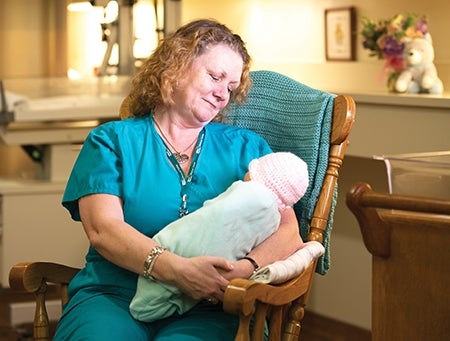Mary Lou Dolan decided she wanted to be a hospital volunteer after undergoing gastric sleeve surgery at Milford Regional Medical Center.
Although her recovery was going well already, a pair of volunteers, Jim and Kelly, stepped in to help Dolan, a Millville resident, following her December procedure. Both received the weight loss surgery at the hospital too, and it was their job to get Dolan up and walking.
“Having somebody that has gone through it already is a great help,” said Dolan, a Millville resident. “They’re also living proof that (the surgery) works.”
Right away, Dolan knew she wanted to offer the same help to patients. This spring, she completed a training program and now visits patients recovering from weight loss surgery on a weekly basis.
Dolan is part of a large pool of volunteers at Milford Regional, which, like all area hospitals, maintains a vibrant volunteer program that enhances virtually all facets of hospital operations.
In fiscal year 2016, Milford Regional received help from 511 volunteers, said Elaine Willey, director of volunteer services for the 145-bed community hospital.
“There are a lot of wonderful people in the community, and all the communities, who want to provide meaningful help,” Willey said.
Measuring volunteerism
According to the U.S. Bureau of Labor Statistics, 6.6 percent of the nation’s 62.6 million volunteers in 2015 worked in hospital or other healthcare settings, making it one of the largest sectors attracting volunteers, behind education, social services and religious outreach programs.
Willey said many of Milford Regional’s volunteers are retirees looking for fulfilling ways to use their time, while others may be considering careers in the healthcare sector and are trying to get their feet wet. And then there are some that just have a strong connection to the hospital, because they or their family members received care there.
There’s a steady stream of applicants, making it easy to keep vital volunteer roles filled.
“We’re really fortunate that I rarely have to recruit for roles,” said Willey, a social worker who has worked for Milford Regional for 17 years.
Finding a match
The real challenge is matching people with programs that are suited to their interests and strengths. Some programs, of course, are more popular than others. Newborn cuddler programs, where volunteers hold babies exposed to opiates in utero to ease the withdrawal process, are very popular. There’s a waiting list to hold babies at Milford Regional, as well as at UMass Memorial Medical Center and Saint Vincent Hospital in Worcester.
But there are myriad opportunities to help in hospitals, whether it’s sorting mail, working in the gift shop, greeting families and patients in crisis in the emergency room, or helping elderly patients who may become disoriented at night. Some roles are fraught with emotion, such as the Compassionate Companion program, which Willey implemented in 2011, providing around-the-clock companionship with patients receiving hospice care in their final hours.
Jody Stark Cornetta, director of volunteer services at UMass Memorial, said it’s important to balance volunteers’ interests with the demands of the different departments. Onboarding employees is an in-depth process akin to applying for a job, and volunteers can’t simply float from one department to another.
“It’s very important to have the right match. You want to have a volunteer who likes what they’re doing and are fit for the department,” said Cornetta, who managed 801 volunteers at UMass Memorial last year, ranging in age from 15 to 96.
One of them is Renee Leoncini, who retired at 55 and quickly found her niche volunteering in the emergency room and in the pediatric ward at UMass Memorial. She spends two hours a week helping patients in the emergency room feel more comfortable, finding pillows and warm blankets, or sometimes just chatting. Her other two weekly hours are spent making ice cream sundaes for pediatric patients, their families, and the staff.
“That’s my fun time,” said Leoncini, adding that she hopes to continue for the long term, like some of her fellow volunteers who have been with the hospital for 30 years or more. “I can see that happening for me.”
For the busy clinical staff, hospital volunteers are an extra set of hands to help meet patients non-clinical needs. Christine Case, volunteer coordinator at Saint Vincent Hospital in Worcester, said volunteers are onboarded and receive annual reviews like any employee, becoming part of the department.
“The staff really loves having the volunteers here. They do so much for the hospital,” Case said, adding that they’re not seen as “outsiders.”
Maximizing performance
Case said their biggest contribution is to improving patient experience, but a report published in January by the American Hospital Association (AHA), a national advocacy group for about 5,000 hospitals and healthcare systems, found that volunteers help maximize hospital performance, too.
In a series of case studies, the AHA provides examples of volunteer programs that have boosted healthcare utilization, provided valuable training for student volunteers who will become part of the workforce, curbed per-capita healthcare spending, and even reduced hospital readmission rates, all pressing goals for hospitals that are facing growing pressure to improve patient experience while maintaining already lean margins.
Pat Noga, vice president of clinical affairs at the Massachusetts Health and Hospital Association (MHA), the state’s hospital industry group, said hospital volunteerism is becoming more important, as hospitals invest in programs that boost overall patient experience, a measure that the Centers for Medicare and Medicaid now ties to insurance payments for its members. Noga noted that hospitals now often employ “directors of patient experience,” or “chief experience officers.”
Noga said the more people on hand to boost the experience, the better.
“It can make a difference, who sees you, who helps you along your way,” Noga said.

